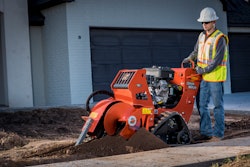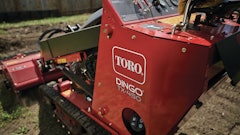Check out the video, right here:
At the recent Rental Show 2021 in Las Vegas, we got a first look at not one, but two new machines that represent market entries for the OEMs behind them. First was the Sany SLB95, the first backhoe loader for Sany America. Check out our coverage of that right here if you haven’t already.
The second is our subject today: the SM100 is Wacker Neuson’s first mini skid steer.
Now, these machines go by a few different names, depending on who you talk to or the manufacturer of the particular machine you’re looking at. Wacker Neuson calls it utility track loader. Most of you probably call it a mini skid steer, while others call it a compact utility loader.
Whatever you want to call it, even though it’s a first step into a fast-growing market for Wacker Neuson, it’s a very confident first step and there’s a lot to like with this machine, so let’s dig in.
Hot market
For starters, and a little bit of context on the market for this mini skid steer category, whether it was intentional or not, the SM100 is a very compelling answer to the SCL1000 that Kubota unveiled last year at ConExpo 2020. The SCL1000 itself was a first step into the market for Kubota that made a very strong first impression.
And before we go any further, we need to establish that this market is one of the hottest in the equipment industry. Some of that is due to the popularity, dominance, and familiarity of this machine’s big brother, the compact track loader. But some of it is also due to the sheer versatility of the mini skid machine category.
While this category used to only be able to lift 500 or 600 pounds, OEMs have been stuffing more and more power into these machines as the years have gone on. The SM100 offers 1,000 pounds of capacity, but the category as a whole includes machines with up to 3,000 pounds of lifting power.
In that range of 1,000 to 3,000 pounds, you’re firmly into power formerly reserved for skid steers and CTLs. And the cool thing about mini skid steers is that they not only allow you to use skid steer and CTL attachments like post hole diggers, snow blowers and obviously forks and buckets, but you don’t have to crawl in and out and over those attachment to operate it.
That combination of power, versatility and the efficiency of hopping on and off the operator’s platform has been a game changer for a lot of markets—landscaping and hardscaping in particular. Plus, a mini skid is a good bit cheaper than either a CTL or a skid steer as well.
“Every rental house in North America has a ride-on or walk-behind utility track loader. So the industry has been growing very rapidly over the last decade—20 or 30+ points of growth every year—and we see this as a nice complement into our business portfolio being a light equipment and a compact equipment company, this fits right into the middle of that,” said Joe Miller, Vice President of Sales and Marketing at Wacker Neuson.
The sweet spot
Another aspect of the mini skid steer that has attracted a lot of new attention is this category’s growing power and capability. OEMs have honed in on a market sweet spot in that respect over the last few years.
Specifically, that sweet spot matches at least 1,000 pounds of lift capacity with versatile tool carrier capability, and puts it all into a small package that can shimmy into backyards while not disturbing the ground underneath.
That sounds like a lot to ask for one machine, but it’s a package that’s extremely attractive to a lot of customers from several different markets, whether it’s landscaping, residential construction, or rental. Up until now, you could really argue that no OEM had really hit the sweet spot in this market—that 1,000 pound lift capacity mated to a 35-inch width—better than Kubota’s SCL1000.
That has definitely changed with the Wacker Neuson SM100.
The SM100 is rated at 1,000 pounds of operating capacity at 35 percent of tipping. In terms of size, the SM100 is 35.5 inches wide, making it svelte enough to fit through a 36-inch wide gate.
And beyond capacity and width, the other key spec with this machine category is ground pressure. Given the amount of work these machines do on sensitive underfoot conditions and turf, a low ground pressure is a big bonus.
But it’s kind of a puzzle for OEMs. Because as the machine gets narrower, ground pressure becomes more concentrated. So, typically the way to solve this is to go with a wider track width, but then you run the risk of giving up precious inches on the width.
But this is another area where the SM100 shines. At 35.5 inches wide, it’s half an inch narrower than the Kubota SCL1000, but it has a nearly identical ground pressure. While the Kubota machine has 4.0 PSI, Wacker Neuson’s SM100 comes in at 4.1 PSI.
What’s impressive about the SM100 is that it clocks that ground pressure rating with a track that’s nearly an inch narrower than the Kubota. The SM100’s standard track width is 9.1 inches, but the company does have plans to offer narrow and wide track options for the machine as well.
Stability and stand-out specs
Speaking of the track, the SM100 features a high-drive undercarriage design to keep the sprocket out of the dirt and away from at least the majority of what you’re moving through.
The undercarriage also features a triple flanged roller design. Beyond ground pressure and width, stability is the other key factor in the SM100’s design and the machine’s undercarriage design is paramount in that equation.
“So, you’re looking for stability in the machine to be able to lift 1,000 pounds and control it, and then to still be able to ride on that machine and maneuver and still have that stability when you have 1,000 pounds on it,” Miller said. “Part of that is keeping the weight of the machine lower to the ground.”
At the end of the day, when it comes to this 1,000-pound ROC subset of mini skid steers, the SM100 is the only machine on the market that combines 1,000 pounds of capacity, a 35-inch width and 4.1 PSI. In the past, the only machines to get close to this level of low ground pressure were machines that added at least six inches to the machine’s overall width.
The thing really to keep in mind with this type of machine is how tightly linked all the key specs are. The lifting power, and the size and really the actual design of this stand-on category.
I reiterate that here because I’ve heard from Wacker Neuson and at least one other OEM that they believe that once you get over 2,000 pounds or so in lifting capacity this stand-on form factor starts to make less sense, because at that point you’re using that machine for more production type work anyway—work where you’d want to actually be seated.
Speaking of loading trucks, another standout spec for the SM100 is its hinge pin height.
Wacker Neuson is calling the lift path on this machine an “optimized radial lift pattern” that gives the machine 85.7 inches of lift height—enough clearance for loading into high-sided trucks and enough reach for loading into truck beds.
Moving on to power, at the heart of the SM100 is a liquid-cooled, 4-cycle, 3-cylinder, turbocharged Yanmar Diesel engine. The 3TNV80FT. This engine makes 24.7 horsepower and produces a max torque of 62.6 lbf at 1,800 rpm. Hydraulically, the SM100 is rated at 13 gallons per minute and 3,045 psi.
Moving to the operator’s station, this is an aspect of the machine Wacker Neuson says it paid particular attention to in order to ensure a comfortable ride.
The standing platform is supported by a spring suspension that ensures you’re stable on the platform on any terrain. The operator’s station also features a padding around the inner frame and Wacker Neuson has also implemented front-mounted coolers to keep hot air off your legs while operating.
In terms of maintenance, because this machine is so small and low to the ground, all of your daily check points are right there under the hood for very simple accessibility .
The SM100 made its debut at The Rental Show 2021, where Wacker Neuson said it was one of its most popular machines in terms of new orders. The SM100 will start shipping in the coming months.





















